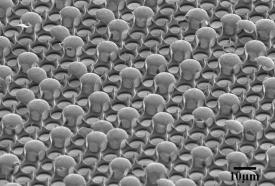

07/27/2009

Picture a rose, in full bloom, after a rain shower. Water droplets bead up on the petals, but they do not slide off — instead, the petals grip the droplets in place, even if the flower is inverted. The secret to the water-retaining power of rose petals? A microstructured surface with both hydrophilic (water attracting) and hydrophobic (water repelling) regions.
The field of biomimetics seeks to reproduce natural technologies, such as the adhesion properties of rose petals, with synthetic materials. Now, Masatsugu Shimomura and co-workers from the Advanced Institute for Materials Research (AIMR) at Tohoku University1 have developed a new biomimetic surface composed of self-organized metal-polymer structures, which can be made to repel or cling to water droplets.
According to Daisuke Ishii, the lead author of the study, creating a biomimetic material with adjustable wettability requires precise dimensioning of the hydrophilic and hydrophobic surface patterns. If the patterns are too large, the regions act independently, making it impossible to control water droplets. Similarly, patterns that are too small compared to the size of the droplet have little effect on the droplet’s behavior.
“Our surface is composed of micrometer-sized hydrophobic–hydrophilic patterns,” says Ishii. “As a result, water droplets are simultaneously repelled and adhered on our hybrid surface.”
The researchers combined hydrophilic metal domes with super-hydrophobic polymer spikes to create their new biomimetic surface. “By fabricating a polymer and metal hybrid, we hoped to make a functional surface with wettability that responds to external stimuli,” explains Ishii.
First, the scientists cast a thin polystyrene-based film onto a glass honeycomb-patterned template to form hexagonally ordered microcavities. This honeycomb film was then coated with nickel metal, which filled many of the cavities. By peeling off the polymer film layer, the researchers obtained a series of metal domes and empty cavities amidst an array of polymer spikes (Fig. 1).
Ishii’s team prepared a range of these biomimetic surfaces by varying the surface metal concentration. They found that altering the metal dome coverage from 0% to 25% changed the surface’s properties from completely water-repellent to as water-adherent as a rose petal.
Manipulating wettability through external stimuli is the ultimate goal of the researchers. “Adhesion properties can be controlled by using the electric and magnetic energies of the metal microstructures,” says Ishii. “We will demonstrate micro-droplet manipulation on the biomimetic surfaces for new micro-fluidic and lab-on-a-chip devices.”
Ishii, D., Yabu, H. & Shimomura, M. Novel biomimetic surface based on a self-organized metal–polymer hybrid structure. Chemistry of Materials 21, 1799–1801 (2009). | article
This research highlight has been approved by the authors of the original article and all information and data contained within has been provided by said authors.